350 Search Results for aided language input
January 31, 2018
by Carole Zangari -
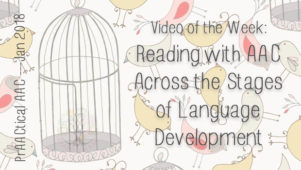
As we all know, our AAC intervention must be differentiated to meet the needs of individual learners. In today’s post, we share a number of videos by the wonderful team at Communicare in Massachusetts. In these videos, they demonstrate how to read the same book and adjust the goals, aided language input, comments, and questions for AAC learners at 6 different stages of language development. Many thanks to this wonderful team for making these videos and sharing them publicly. You can learn more from Nerissa Hall and Hillary Jellison here.
April 14, 2016
by Carole Zangari -
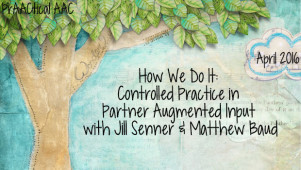
Today, we welcome back Dr. Jill Senner and Matthew Baud to talk about some of their strategies for implementing AAC. They have some great ideas for helping partners better support AAC learners. You can read some of their previous posts here. In the meantime, let’s see how they are helping communication partners develop their AAC facilitation skills. :::::::::::::::::::::::::::::::::::::::::::::::::::::::::::: Most of us already know that evidence-based research supports the use of partner-augmented input (PAI) as an intervention strategy for individuals who use AAC. However, simply having awareness of a strategy does not mean that one can easily use it. To quote Jim Knight, “We wouldn’t teach someone to drive by giving them a lecture, tossing them a book, and then turning them loose on the freeway.” Indeed, in order to learn a new skill, communication partners often need practice. In fact, one may need to try a new strategy or skill... [Read More...]
December 7, 2015
by Carole Zangari -
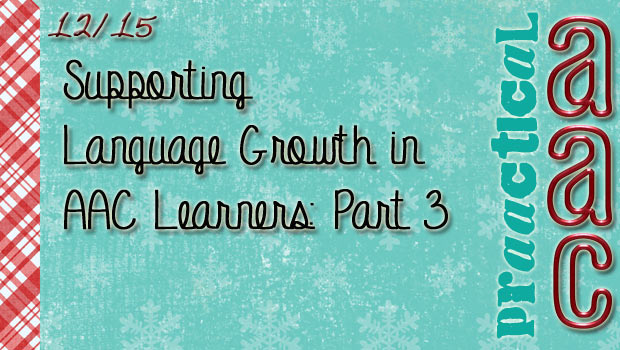
In some earlier posts, we looked at conversations with AAC learners who communicate with single words or short utterances, and began thinking about ways to stretch their language learning. In this post, we’ll continue to explore ways in which our intervention can facilitate language growth. Let’s start with an example of a typical conversation between an AAC learner and his/her therapist. Activity: Book reading [with aided language input] SLP: Look at all these animals! [Expectant pause] Marcus: Bird. SLP: Yes, lots of birds there. Those are seagulls. What else do you see? Marcus: Fish. SLP: It looks like a fish. That’s a dolphin. Dolphins are mammals. Remember from Ms. Louis’s class when you read Day of the Dolphins? Marcus: Swim SLP: Yes, they are really good swimmers. From the standpoint of shared meaning, this conversation has some good features. But even just reading the dialogue online, I bet you... [Read More...]
October 27, 2015
by Carole Zangari -

As far as I can tell, most AAC learners are taught by people who don’t specialize in AAC. Their school SLPs may have caseloads of 50, 60, 70, or more students with IEPs, 90% of whom have goals for articulation, language, and fluency. Their classroom teachers serve students whose disabilities range from none at all, to dyslexia to cerebral palsy, to significant intellectual disabilities, and everywhere in between. In all likelihood, neither group had much AAC training. What little AAC they know, they’ve picked up on their own from reading, going to workshops and conferences (usually self-funded), talking to colleagues, and exploring online resources. Many times, their first foray into AAC is with things like choice boards and visual supports, such as daily schedules and first/then boards. From there, they may begin labeling the environment with pictures symbols (e.g., ‘table’ on the table, ‘on/off’ near the light switch), using mini-schedules... [Read More...]
April 30, 2015
by Carole Zangari -
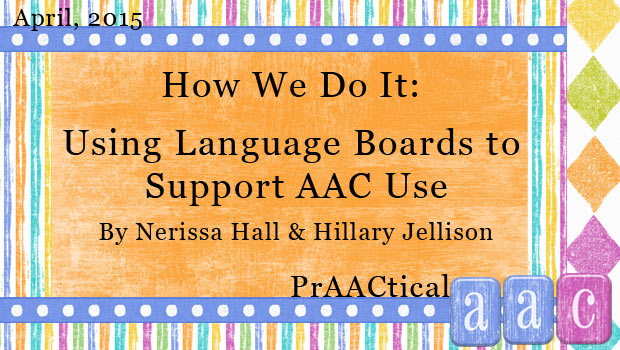
Many of you have reached out to say how much you’ve appreciated the prAACtical suggestions provided by Nerissa Hall and Hillary Jellison, New England-based SLPs and owners of Commūnicāre, LLC. We’re excited to have them back, especially because they are talking about something near and dear to our hearts: Implement a core vocabulary approach in their AAC therapy. In this post, they give us a peek into the ‘why’ and ‘how’ of making and using communication boards that are rich in core words. In their typically generous fashion, they also share templates for the boards that they make. How We Do It: Using Language Boards to Support AAC Use There are a number of different strategies one can use to support an individual’s use of augmentative and alternative communication (AAC). We know that aided language stimulation, augmented input, and AAC modeling are important and effective ways of supporting AAC use. By using... [Read More...]
April 9, 2015
by Carole Zangari -
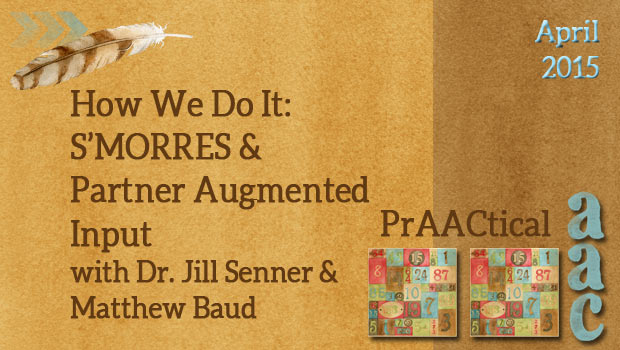
Mnemonics are such a great memory aid, so when Dr. Jill Senner and Matthew Baud offered to share the visual support that they use in their clinical work, I knew it would be of interest to many of you. Combine that with content on partner training, and we have a real treat for you: S’MORRES. Dr. Senner is the owner of Technology and Language Center where she specializes in providing AAC and AT services including assessment, consultation and training, and workshops/lectures. She has presented at numerous national AT conferences and has taught graduate courses in AAC and swallowing disorders. Matthew Baud is the Assistive Technology Coordinator at Niles Township District for Special Education, performing evaluations, trainings and coaching communication partners. Matthew also has his own AAC private practice, and is an adjunct professor at Saint Xavier University where he teaches a graduate course in AAC. In this post, they share S’MoRRES, a strategy for building... [Read More...]
August 28, 2014
by Carole Zangari -
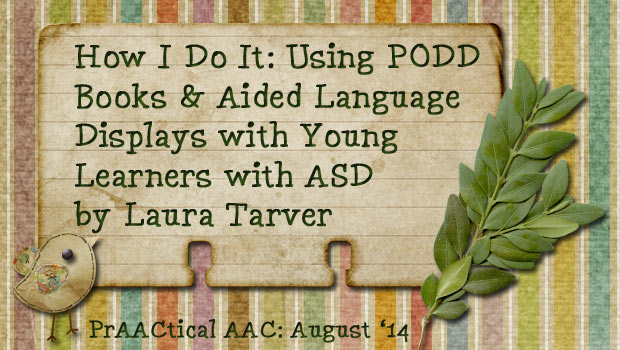
Today, we turn to the UK in a guest post by Laura Tarver. a London-based Speech and Language Therapist working with children with ASD and other complex needs. She previously worked in a primary school for children with ASD, where PODD and Aided Language Displays were introduced as part of a school wide approach in order to enhance the communication-friendly environment for all pupils. In this post, she shares how they used PODD books and aided language input to build the students’ communication skills. :::::::::::::::::::::::::::::::::::::::::::::::::::::::::::::::::: PODD (or Pragmatic Organisation Dynamic Display) communication books were developed in Australia by Gayle Porter, originally for children with cerebral palsy. As their use becomes more widespread throughout the world, practitioners are considering the benefits of using them with other clinical populations. Their structured organisation and emphasis on visual communication means that they are also a valuable tool for developing the communication of those with... [Read More...]
January 23, 2014
by Carole Zangari -
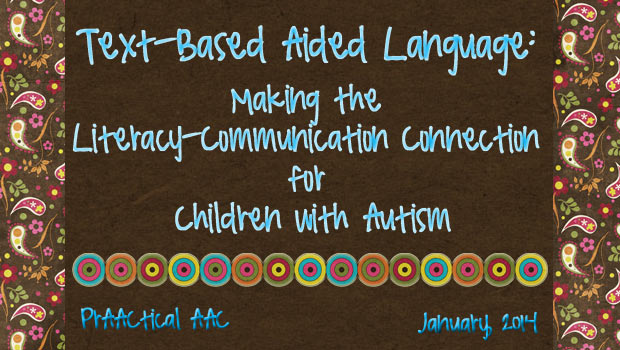
We are so pleased to have this guest post by Alicia Garcia. She is the lead SLP at AAC Clinic at One Kids Place, in Ontario. You can read her previous post here. Today, Alicia takes us in a textual direction. Enjoy! When working with children with autism who have complex communication needs we have found it is not uncommon to see children who, despite having significant communication and language challenges, can read and sometimes type words. Their ability to decode written words is far superior to their ability to communicate their wants, needs and thoughts. Some of these children use AAC systems for their face-to-face communication and, in some cases, have a literacy program in place; they frequently have handy access to writing or typing tools. These children do not, however, use text to communicate with people. They have not made the Literacy-Communication connection. We wonder… how do we help these... [Read More...]
August 20, 2013
by Robin Parker -
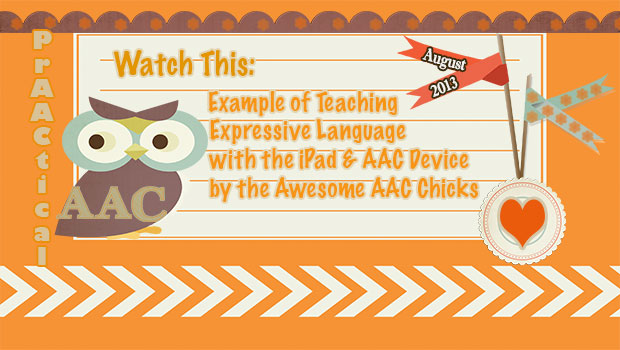
Here is authentic AAC teaching by the AAC Chicks. Watch for the combined use of AAC language facilitation strategies. Can you see: aided language input, wait & signal/time delay prompt, specific reinforcement, expansions, scaffolding, modeling, and more. Also, for the SLP’s, notice the data collection that does not distract from the session.
August 7, 2013
by Robin Parker -
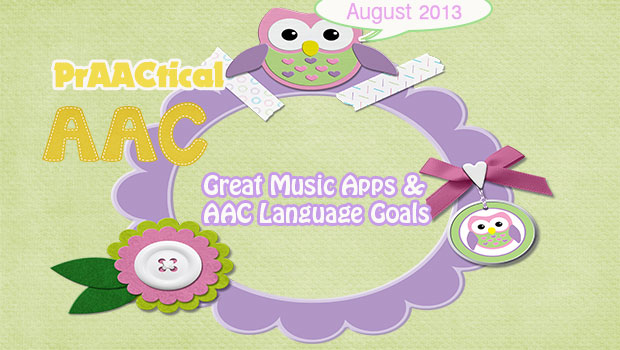
We love music, we love apps, we love great language opportunities and with these apps we can combine all these loves. These awesome music apps were selected because they have great choice making and commenting opportunities. You can use no tech, low tech, or an extra high-tech device to make choices and comment while you play with the app. Core words work great for choice making and commenting. Whenever I play or sing, my kids love to say “stop that” or “don’t do that pleeeeease”. When they play, I love to use aided language input (ALI) to say “good”, “more”, “again”, “love it” . We play the music “fast” and “slow”. We “find” our “favorite one”. We all like to say “let’s play with that one” or “let’s do it together”. The possibilities are really endless (and that is one of the reasons we love core words). These apps sound... [Read More...]









